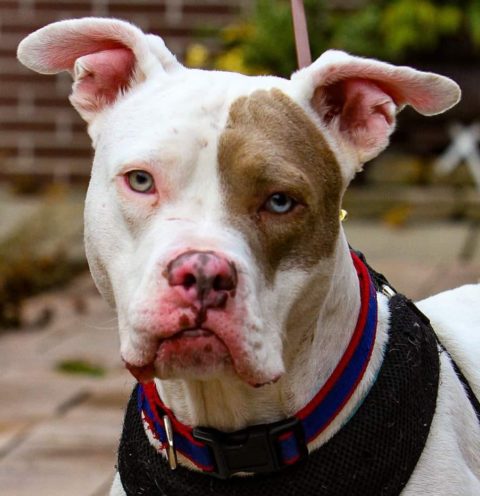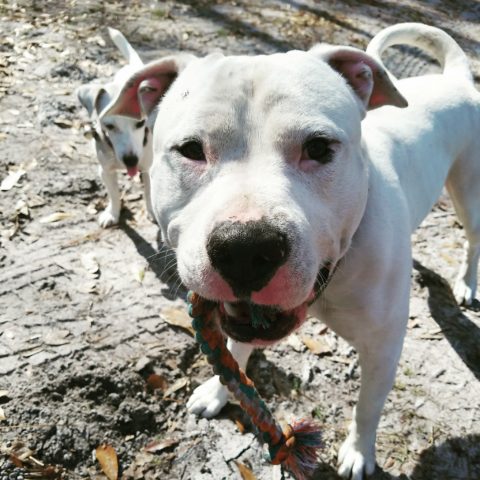A Deaf Dog Joins Your Family–Do you need to learn sign language?

photo credit: Vicky Darnell
Have you adopted a deaf dog or just found out that the dog that you adopted is deaf? Often people feel anxious, scared, and sad when they realize their dog is deaf. In fact, these emotions are pretty typical. People feel afraid and aren’t quite sure how to proceed. They feel like they are alone and that no one quite understands their current predicament.
Too, they may feel upset that they have found themselves in this situation with a dog without the ability to hear—which they might feel puts them at a disadvantage.
While these emotions are valid I can tell you that sharing your home and life with a deaf dog has many advantages. Thunderstorms, vacuum cleaners, and fireworks won’t cause distress in your house! Additionally, often visual (vs. verbal) cues are more relevant for dogs. That is, if you were to say, “sit” and gesture for your dog to put his bottom on the floor, the version of the cue that he’s actually responding to, were we to test it out, may be more likely the visual option.
So now that you have a deaf dog, where do you begin? Let’s frame our plan via the acronym CALM—Communication, Attention, Life Skills, Modify behavior. You can think of CALM as a way to remember the steps to help you move forward in an order which makes the most sense.
COMMUNICATION
Frequently people believe that you need to start with an official sign language such as ASL (American Sign Language) or BSL (British) or JSL (Japanese). However, the very first step needs to be to establish a communication tool. This means that you want to begin to condition a marker. With hearing animals this often takes the shape of a clicker or a verbal marker like the word, “good.” With a deaf dog the marker would be a visual (or tactile) one—like a “hand flash,” or “thumbs up” sign. Just as with an auditory marker, you need to be sure to pair the marker with something your dog finds reinforcing—every single time. This ensures that the marker retains its value.
ATTENTION
Next, you need to get—and keep–your dog’s attention. You can do this via both teaching a “look-at-me” cue as well as capturing (then shaping duration for) a check-in behavior. This means teaching your deaf dog to look at you as well as “catching” him when he looks at you. You want to make it worthwhile for your dog to make eye contact and you want to communicate that continued and periodic eye contact is a reinforcing behaivor for him. Keep in mind that behaviors that are reinforced are repeated, so you should reinforce eye contact frequently and consistently.
LIFE SKILLS
Now that you have an effective way to let your dog know when he performs behaviors that you like and want to see more of, plus he’s checking in with you regularly, you can begin to work on some key, important skills to help him navigate life in your home. Building block behaviors like targeting, where he touches a part of his body to a target, and stationing, where he learns to relax, calmly in a particular spot are important skills that you can begin to teach and reinforce early and often.
MODIFY BEHAVIORS
Finally, now that both your dog’s (as well as your own) skill sets are continuing to grow you might encounter some behaviors that you would prefer not continue. In this case, you first want to figure out why the behavior is present. Then you can sort a plan to change or modify the behavior. You want to rule out any medical cause for the behavior as a first step. After that you can work to teach incompatible or alternative behaviors that you can mark and reinforce. Consistently marking and reinforcing behaviors that you want to see continue helps to build up a strong reinforcement history—and behaviors which have a long history of reinforcement are those that you will see most frequently in the future, too.

Photo credit: Taylor Haze Jackson
Overall, sharing your life with a deaf dog doesn’t need to be difficult and can be very enriching. It really just involves a perspective shift. It is like putting on glasses for the first time where the world goes from fuzzy to clear and you realize it just took a slight adjustment to make things fall into place. The same is true with working with a dog without the ability to hear.
Even if you don’t have a deaf dog in your life, practicing some visual or tactile cues can help to expand your training repertoire and perhaps make your communication more effective overall.
Changing your perspective to using non-auditory communication and becoming more fluid and comfortable with communication, attention, life skills, and behavior modification tools will set everyone up for success!
